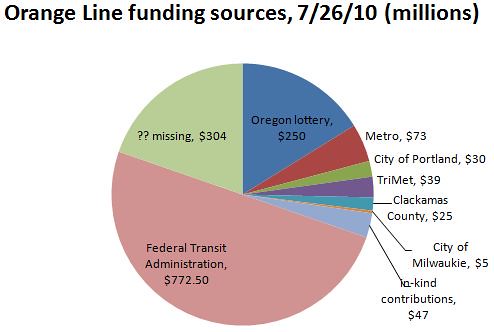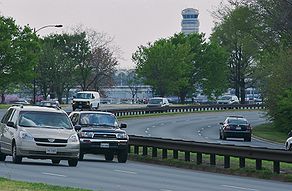There's an
article on the light-rail advocacy site
lightrailnow.org, which introduces a concept known as Rapid Streetcar. Rapid Streetcar, as they define it, is a rail transit system which is a hybrid between "traditional" mixed traffic streetcars, and light rail systems. With a rapid streetcar design, streetcar-class rail vehicles (which weigh considerably less than light rail vehicles) are operated in exclusive rights-of-way in urban areas, often in lanes which were previously dedicated to automobile service, and often in multi-car trains. The page goes into detail on the advantages (lower construction cost, ability to run in mixed traffic if necessary, the possibility of
tram-train like operation) and limitations (speed and capacity) of such systems, and discusses Portland's rail systems in great detail.
Of course, there's one catch:
Portland doesn't HAVE any Rapid Streetcar. The article primarily uses Portland's streetcar system as an example of how such a system
might be designed (focusing on details such as construction costs and techniques, station design, etc), while glossing over the fact that Portland Streetcar is, at present, a mainly mixed-traffic circulator system, not something marketed as rapid transit (or rapid anything). Portland does have rail lines with service parameters that satisfy the conditions for Rapid Streetcar--but those lines (such as the Yellow Line) are running light-rail rolling stock, not streetcars. There has been some
discussion of Rapid Streetcar in Portland, but currently none exists.
As the article notes, "Rapid Streetcar" is not really a novel idea; many European tram systems have been operating in this fashion for decades. It is more novel in the American context--the legacy streetcar systems which operated in the early 20th century before being replaced with busses and the automobile, were almost always mixed-traffic types; and many of the "revival" streetcars, such as the Portland Streetcar, are this way as well.
The Portland rail divide
The Portland metropolitan area has three transit rail systems in operation;
this post compares the three systems (along with two "full metro" systems in other West Coast cities). The remainder of the present article will ignore everything but MAX and Portland Streetcar.
In many ways, the two systems are dramatically different.
MAX is a traditional light-rail system, operated by
TriMet--a mobility-focused transit agency which also provides bus service to the bulk of the metro area. MAX uses light-rail class vehicles (such as the Siemens S70), usually running in two-car trains. It runs almost exclusively in its own right-of-way, and in many places it is built to "light metro" standards, with grade separation or guarded crossings. Other than the downtown area, average stop spacing on MAX is generally 3000-3500 feet (1km); and average speed on the system is about 20MPH (32km/h). MAX operates on the proof-of-payment system, with tickets vended at platforms. The fare structure for MAX is the same as for TriMet's bus system (with the added benefit of the
Free Rail Zone downtown); service is branded similarly to the busses (both use the same colorschemes); and MAX is not marketed in any way as a premium or upscale service. (Many of the MAX lines pass through parts of town regarded as blighted, and the "MAX causes crime" meme is unfortunately popular ).
Portland Streetcar, on the other hand, is a different beast. While TriMet drivers drive the trains around, the Streetcar is owned and operated by
Portland Streetcar Inc (PSI), a subsidiary of the
City of Portland. Unlike TriMet, PSI is focused on urbanist and community-development outcomes; on "placemaking". The Streetcar uses streetcar-class vehicles (the
Skoda 10T) operating in single-car units, and provides local circulator service through downtown Portland. It operates in mixed traffic, mostly on streets of secondary importance. Average stop spacing is about 750' (230m), or about once every three blocks. Average speed is less than 7MPH (11.1 km/h); slower than many busses. The Streetcar also uses the same fare system as MAX and the busses (and passes and transfers are interchangeable between the systems)--however, the Streetcar is marketed differently, with a brightly-colored colorscheme and styling aimed at more upscale riders. Onboard amenities are similar. The Streetcar also operates on a proof-of-payment basis, albeit with ticket machines onboard rather than at platforms.
Divide is perhaps too strong a word--as the two systems coexist fairly well. The two agencies are on friendly terms, despite differing missions, and the systems are presented to the public as parts of a unified transit system. Presently, they cross each other in two places (at Portland State University, and where the Yamhill/Morrison and 10th/11th couplets intersect), with a third crossing near the Portland Convention Center coming in 2011 when the
Streetcar Loop project opens. However, at the present time, the two systems are completely separate--separate routes, seperate rolling stock, separate yards and maintenance facilities, separate organizations, and separate missions.
Change coming
The opening of the Streetcar Loop project in 2011 won't change any of this. However, when the Milwaukie MAX line opens in 2015, a shock to the system will come. The new Caruthers bridge, which will ferry MAX across the river
south of downtown, will also carry Streetcars as the Streetcar Loop project is completed to become a real (bidirectional) loop winding through both sides of the Willamette River. For the first time, MAX trains and Streetcars will share the same tracks while in revenue service. They won't share any stops--Streetcars will pass through the MAX stop on the west side of the bridge without stopping (and the lines diverge immediately after that), but they will share rails and catenary.
The next planned Streetcar project after the Loop is the
Lake Oswego transit project, which everyone expects will select Streetcar as the LPA (locally preferred alternative). This project, planned as a southward extension of the current Streetcar service down the
Jefferson Branch line, is being
billed by some (including local
planners) as Rapid Streetcar. However, the
predicted speed of the line--approximately 19MPH (30km/h), is on the low edge for a rapid transit line. South of South Waterfront, the line is projected to be fairly fast; however the present Streetcar route takes ten minutes between OHSU and PSU. (Planned
enhancements to the line should shave a few minutes off that; however the numerous stops along this stretch of the route limit the impact of track improvements). Further, the proposed project may suffer from capacity issues--as much of the route is single-tracked, effective headways are limited to 12 minute (5 trains per hour), or 700 pphpd. Finally, one other significant issue is that whereas the #35 bus (which the line intends to replace) travels the transit mall, the Streetcar extension would instead stay on the existing alignment along the 10th/11th couplet--a five block difference. Many of the commuters from West Linn who use the #35 either work downtown or plan to transfer to another line on the Mall; and are not well-served by a line which instead takes them to the Pearl District).
Streetcars on the Mall?
Given all that--what if the Lake Oswego Streetcar, instead of being an extension to the existing line, were instead routed on the Transit Mall? Doing so would provide the following advantages (albeit with the indicated conditions).
- Better replace the #35 service than a 10th/11th alignment. Operation on the Mall would deliver riders to the core of downtown Portland's commercial district, and to all the transfer opportunities found there.
- Would make running trains--i.e. more than one car--a possibility. As the current Streetcar alignment north of PSU runs through existing, mature urban fabric, and in mixed traffic, the service is limited to single-car "trains" in order to minimize impacts. The transit mall, OTOH, already serves 2-car MAX trains (equivalent in length to three Streetcars) with no difficulty. Much of the line south of PSU could more easily be expanded to accommodate larger vehicles; permitting the LO line to have capacities closer to what MAX can deliver.
- To further improve performance, the proposed Harbor Drive transitway (connecting the new Caruthers bridge to Lincoln Street) could be modified to accomodate Lake Oswego bound streetcars, thereby skipping many of the intermediate stops
In short, running the LO Streetcar on the Transit Mall would separate the local service (the existing Streetcar line and the loop) from the rapid transit service (the Lake Oswego line).
Now how much would you pay?
[Map courtesy of City of Portland/
thetransportpolitic.com ]
But wait...there's more!
Last year, the City of Portland and Portland Streetcar published a draft
Streetcar System Plan, which was passed by the city council last September. The plan is a document outlining where Streetcar service might go in the city of Portland in the future. The document isn't intended to articulate future corridors for high capacity transit (see
here for that); and limits its coverage to the city of Portland, not to the suburbs. Most of the routes proposed are local circulators such as the current Streetcar; however the document does address Rapid Streetcar, further dividing it up into "enhanced local service" and "priority service", proclaiming the LO Streetcar extension to be the latter. The Plan has this to say on the subject:
The rapid streetcar concept aims to combine the best features of streetcars and light rail transit (LRT) to achieve faster commute/travel times than streetcars and lower system costs than light rail. Streetcars are typically designed to go shorter distances in central cities, densely populated mixed-use centers and neighborhoods. Streetcars are also typically designed to operate in mixed traffic, preserving street traffic patterns.
LRT typically functions as regional high-capacity transit (HCT), generally traveling in a separated right-of-way with relatively fast-moving, larger-capacity vehicles designed to rapidly transport large numbers of people between suburban and urban centers.
The rapid streetcar concept would apply some of the LRT features to streetcars to improve travel times while keeping capital costs lower. It would combine features of a semi-exclusive transitway and transit priority features within the street right-of-way to achieve faster travel times and maintain lower system
capital costs. This could introduce two new levels of service to Portland’s system.
Several corridors under consideration for the Streetcar System Concept Plan are prime candidates to introduce Enhanced Local Service. These corridors are major arterials with 4 to 5 lanes and on-street parking such as NE Sandy Boulevard and SE Foster Road. In Portland there are potential corridors for introducing priority service. Currently, the region is undertaking a study to extend the existing streetcar system along a former railroad right-of-way from the South Waterfront District, through Johns Landing and south to Lake Oswego. SE Foster Road and 122nd Avenue are also candidates where there may be sufficient right-of-way width to introduce streetcar priority lanes.
I encourage all readers to download and read the draft plan--even if (or especially if) you think local service streetcars are a boondoggle or a weapon of gentrification. (The document probably won't change your mind, but it may make you angry).
In the plan, numerous potential Streetcar corridors are considered. Several screening functions are applied to exclude those which are technically unfeasible, unlikely to draw sufficient ridership, or unlikely to promote transformative land use outcomes; with the remaining corridors grouped into tiers. More filtering was performed, with the following routes surviving all the cuts:
- MLK from Alberta to the Loop.
- Thurman/18th/Burnside/Sandy. NW 18th/19th couplet, south to Burnside, east to Sandy to the Hollywood District.
- The loop
- The current route, with extension to Lake Oswego.
- Sellwood Bridge, between LO route and Tacoma Street MAX.
- Gateway Loop
- Goose Hollow to 3rd/4th to Morrison Bridge to Belmont to 39th to Hawthorne to 50th.
- Broadway/Weidler from loop to Hollywood.
The plan assumes that the Powell Boulevard and Barbur Boulevard corridors will be constructed as light rail, and assumes that no sharing of track between MAX and Streetcars will occur, other than on the Caruthers Bridge. If, however, Streetcars could use lower-speed MAX routes to get around, it may be possible to eliminate some redundant routes downtown, or use the existing Ruby Junction yards to service the Gateway Loop. For example, if connectivity to St. Johns were desired, but extending the MLK line were thought to be difficult, it might be possible to lay tracks from Interstate only, and then have trains run down the Yellow Line--or even augment (or replace!) the Yellow Line itself with streetcar service, as a way of dealing with the Steel Bridge bottleneck.
Technical difficulties
How technically (and politically) feasible is any of this? Both systems use the same rail gauge (standard) and power system (overhead catenary supplying 750VDC), so two key requirements for mixing the systems are satisfied. The following technical issues and restrictions do exist:
- The signalling systems are presently different; unfortunately, I'm not aware of the technical details, or how much it would cost to retrofit them to be the same (I imagine the Streetcar, with far fewer miles of track than MAX, would be converted).
- The Skoda streetcars are about 8" narrower than MAX trains--introducing a 4" or so platform gap were a Streetcar to use a platform designed for MAX. That gap, too wide to simply instruct users to mind, could be bridged with platform extenders. (For obvious reasons, MAX trains cannot use Streetcar platforms--but there are many other reasons MAX can't run on streetcar routes).
- MAX trains are too heavy to run on the current Streetcar route, which has a smaller railbed. (The use of the lighter-grade construction is one thing that produces the cost savings attributed to Rapid Streetcar). Nor could MAX take many of the corners successfully.
- The Skoda 10T streetcars have a top speed of 40-45MPH (64-70km/h); making their use on the high-speed parts of the MAX network (anything west of Goose Hollow, the I-84, I-205, and Airport segments, and the Milwaukie Line south of Holgate) inappropriate. Were a faster vehicle available, this would not be an issue.
- According to Curt Ailes at Huston Street Racing, who interviewed Oregon Iron Works president Chandra Brown on the subject, the 10T streetcars cannot be coupled for in-service operation. They have couplers, but Ms. Brown suggested that they aren't suitable for operational use. (Perhaps they are only for towing the streetcars; but the model in question lacks the electronics for tandem operation of multiple units, and/or the horsepower for one to pull another). Skoda makes other streetcars (such as the 14T and its successors) which can be formed in trains; but current practice in the North American streetcar market seems to be to use streetcars are larger busses, and to stick with light rail or metro for high-volume applications.
In addition, there may be political objections as well. As noted above, the two agencies have different missions: TriMet has an operations focus (claims by its critics to the contrary nonwithstanding), and PSI is focused more on land use. PSI board member (and Portland planning commissioner)
Chris Smith indicated, in a
conversation on portlandtransport.com, that the former agency isn't interested in the land use goals of the latter, noting that:
I think it would be fair to characterize streetcar supporters (including the City of Portland) as believing that as soon as the streetcar system is handed over to TriMet it will stop expanding. So unless TriMet changes its culture and mission I don't see the organizations being merged for a long time.
While increased joint operation of the Streetcar and MAX certainly doesn't require a merger between the two organizations, Smith has a valid point: Many in Portland's transit community take a dim view of Portland Streetcar, in particular it's land-use focus--and may extrapolate negative views towards mixed-traffic rail and
transit-oriented development into opposition to streetcars (the technology), even in applications where they make sense from a transit-focused perspective. And, there are probably many on the TriMet operations side who would look unfavorably to an additional vehicle type to deal with.
Final thoughts
Does running Streetcar technology and light-rail technology on the same tracks, beyond the planned Caruthers bridge concurrence, ultimately make sense? It's hard to say--for specific lines, such as Lake Oswego, a good argument can be made. Elsewhere in the system, arguments get sketchier. Long range, it may be the case that a downtown subway is built to handle light rail, and that the surface routes become exclusively served by streetcar. It may be the case that rapid streetcar is selected for future transit corridors such as Powell, which already runs parallel to light rail.
It's also possible that the Lake Oswego project won't survive the DEIS process in its current form; and Streetcar technology is for the foreseeable future only used for local circulators--making the whole subject moot.
But in planning for the future, it's good to keep an open mind, especially in an era where budgets are tight. And just because a vehicle looks like a streetcar, doesn't mean it has to act like one.















